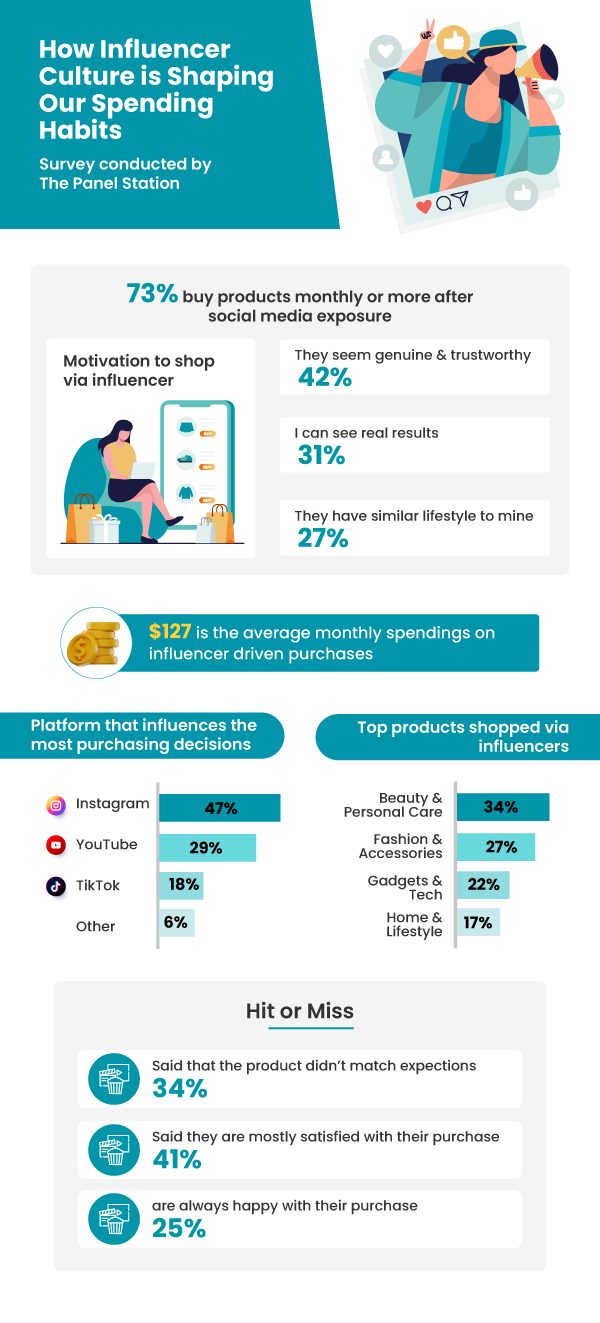We’re living in an era where a single 30-second video can trigger millions of impulse purchases, where strangers on our screens wield more influence over our wallets than our closest friends, and where the line between authentic recommendation and calculated marketing has become virtually invisible. The numbers tell a stark story: 79% of U.S. consumers admit to purchasing products after watching an influencer use them, while a staggering 85% now trust social media influencers more than traditional celebrities when it comes to product recommendations.
This isn’t just about buying a trendy gadget or trying a new restaurant. We’re witnessing a fundamental shift in how purchasing decisions are made – a shift that’s quietly reshaping entire industries and rewiring our relationship with money itself. From the moment you wake up and check your phone to your late-night social media scroll, influencers are subtly guiding your desires, creating needs you didn’t know you had, and turning everyday moments into potential shopping opportunities.
Influencer culture is already affecting your spending habits. But how deeply it has already infiltrated your decision-making process, and what that means for your financial future? Let’s pull back the curtain on this digital phenomenon and explore exactly how social media influencers are reshaping the way we shop, spend, and define value in our lives.
The Evolution of Influencer Types
What started as a celebrity-dominated space has exploded into a multi-layered universe of digital personalities, each wielding their own unique power over consumer behavior.
Before smartphones became extensions of our hands, influence was concentrated in the hands of traditional celebrities. Movie actors, supermodels gracing magazine covers, and championship athletes were the undisputed kings and queens of consumer persuasion. Their endorsements carried weight because they were untouchable, aspirational figures we could only admire from afar.
Then came social media platforms like YouTube and Instagram that democratized influence entirely. Suddenly, anyone with a smartphone and a compelling story could build an audience. This shift didn’t just add new voices to the conversation – it completely rewrote the rules of who gets to influence what we buy, where we eat, and how we live.
As of today, you can see these three types of influencers across social media platforms:
- Macro-influencers: These individuals have huge follower counts, which often range in millions!
- Micro-influencers: They are comparatively smaller than their macro-counterparts, and the follower count usually ranges between 10,000 to 100,000.
- Nano-influencers: These are niche-specific influencers who have massive engagement within their local followers.
How Do Influencers Motivate People to Buy Things
The very first question that you may face today is, how are you even trusting recommendations from people you don’t know personally? Here’s where marketing takes a backseat, and psychology comes into play.
In today’s tech-savvy world, endless scrolling through Insta reels or YouTube shorts has become our favorite pastime. We tend to develop a deep, one-sided connection with these influencers on social media. They become a familiar face in our daily lives, and we start to assume them to be almost like a friend. This makes us follow their routines, trust their opinions, and bring their influences into our lifestyle.
And that’s the exact reason why when these individuals recommend any product or service, it feels more like friendly advice! It is this perceived notion of authenticity that motivates us to buy what they recommend.
Added to that, relatability plays a huge role in this entire game. More often than not, we tend to closely follow those creators whose lifestyle, values, or sense of fashion echo with our own. Hence, when we see them promote products or services that could fit into our lifestyle, it directly affects our purchase behavior.
The Panel Station Insights on the Power of Social Media Influencers
Are you still wondering how influencers affect consumer decisions and define their purchasing behavior? The Panel Station conducted a survey among thousands of online and offline shoppers about their social media-inspired purchases. And in this discourse, we get to know exactly how much of today’s users depend on their favorite influencers to finalize their purchase decisions.

Anatomy of an Effective Influencer Campaign
Now, let’s understand the reasons that make consumers hit the ‘buy’ button based on recommendations of influencers.
So, storytelling stands as a vital element here. Instagram influencers, who transform product recommendations into visual narratives and associate them with their lives, have a greater impact on consumers.
Integration of the products or services into daily lifestyle is also a crucial aspect – to create an impact so solid, that the user feels compelled to purchase.
Other than that, before-and-after content serves as yet another powerful tool. When you witness tangible results, whether it’s clear skin or a clean carpet, it can be incredibly persuasive. Not just that, but this impact can significantly impact online shopping trends as well!
The Dark Side of Influencer Culture
The vast world of influencers isn’t all virtuous. Rather, it has its share of vices, which you need to know to stay careful and make informed decisions about your purchases. So, let’s take a look at the dark side of influencer culture to stay safe and cultivate positive mental health.
One of the primary areas of concern arises from undisclosed sponsorships and misleading recommendations. Many times, influencers don’t state that they’re being paid to promote a specific product or service. This factor erodes trust and deceives their audience completely.
FOMO (Fear of Missing Out) is another drawback of this culture. You’re constantly exposed to seemingly perfect lives and desirable products. This can, in turn, trigger feelings of inadequacy and pressure to consume, thereby leading to negative financial consequences.
On top of that, the rapid cycle of trends promoted by social media influencers contributes to overconsumption. This causes a severe environmental impact due to increased demand for fast fashion. So, despite being a big fan, make sure to consider these factors to stay away from the traps of impulsive spending!
The Key to Making Conscious Decisions
Every scroll through your feed is a carefully orchestrated psychological experiment designed to separate you from your money. The harsh truth is that your financial decisions are increasingly being shaped by people whose primary goal isn’t your satisfaction – it’s their paycheck.
Influencers have perfected the art of disguised persuasion, and their tactics are more sophisticated than traditional advertising. They manufacture social proof by claiming “everyone’s obsessed with this” or showcasing fake scarcity. Most insidiously, they’ve mastered the art of making advertisements feel like friendly advice from someone you trust.
What Should Be Your Practical Defense Tactics
- Create a mandatory 48-hour waiting period before purchasing any product you discovered through social media. This simple delay allows the emotional manipulation to wear off and your logical brain to take over.
- Allocate a specific monthly amount for impulse purchases inspired by social media – and when it’s gone, it’s gone. This transforms mindless spending into conscious choice.
- Regularly take breaks from platforms that trigger your spending impulses. Even a weekend away from Instagram can reset your perspective and reduce the constant barrage of “must-have” products.
- Before clicking “buy,” ask yourself: Would I want this product if I’d never seen it on social media? Am I buying the product or the lifestyle it promises? Can I afford this without affecting my financial goals?
To Sum it Up
Influencer culture has undeniably reshaped how we discover, desire, and decide on what to buy. While it offers exposure to new trends and products, it also blurs the line between genuine advice and paid promotion. As smart consumers, it’s important to pause, reflect, and research before clicking ‘buy’. After all, being influenced should never mean losing control over your choices.









